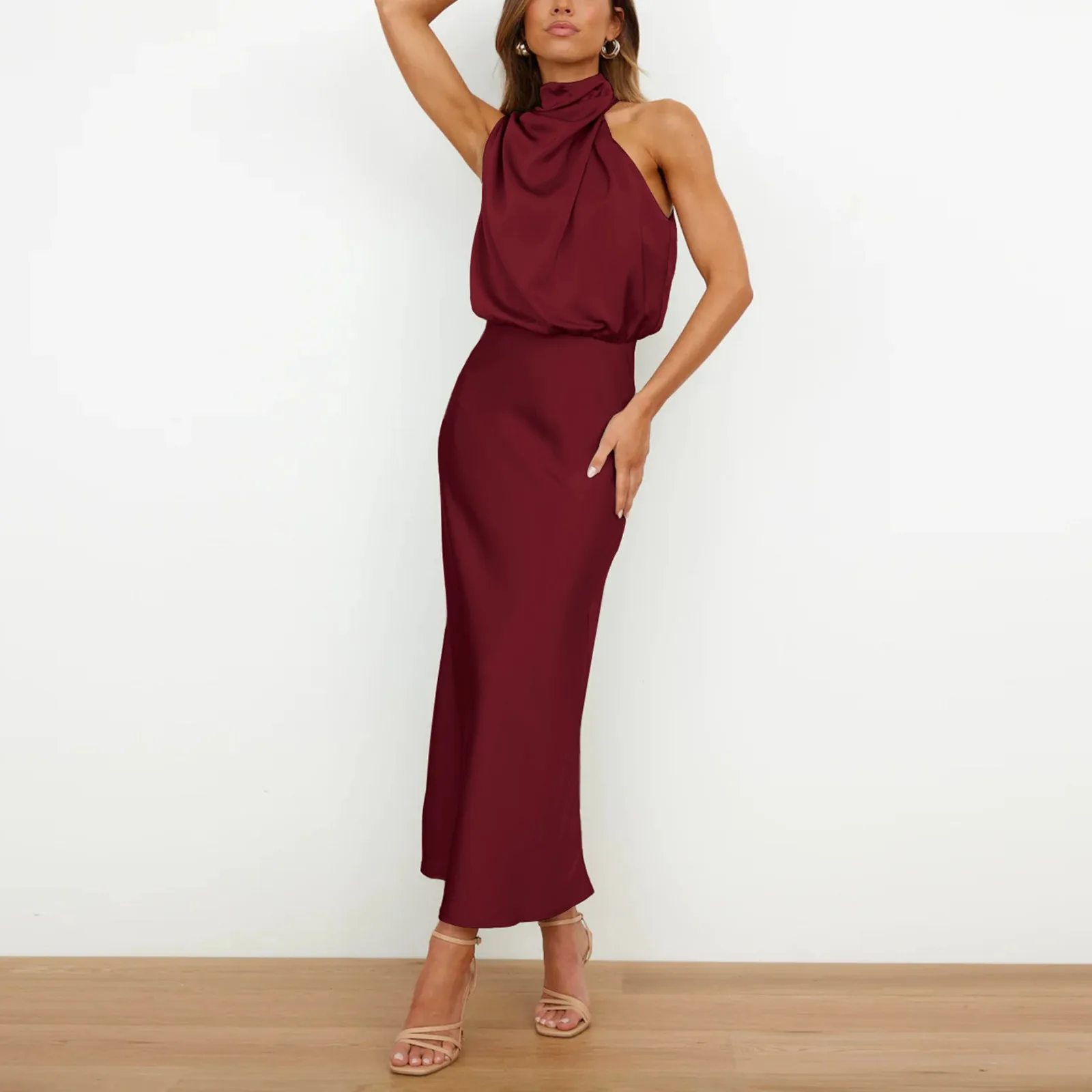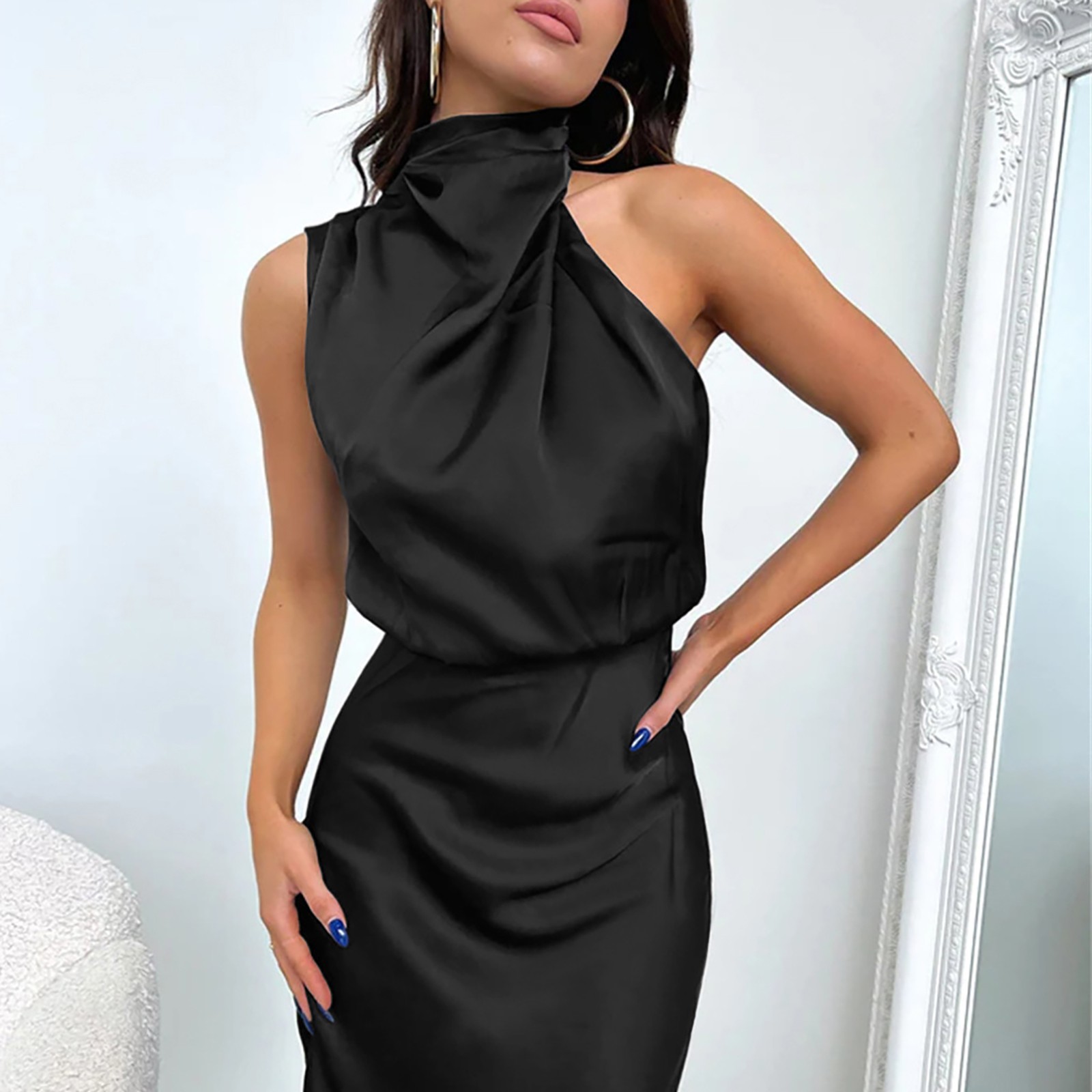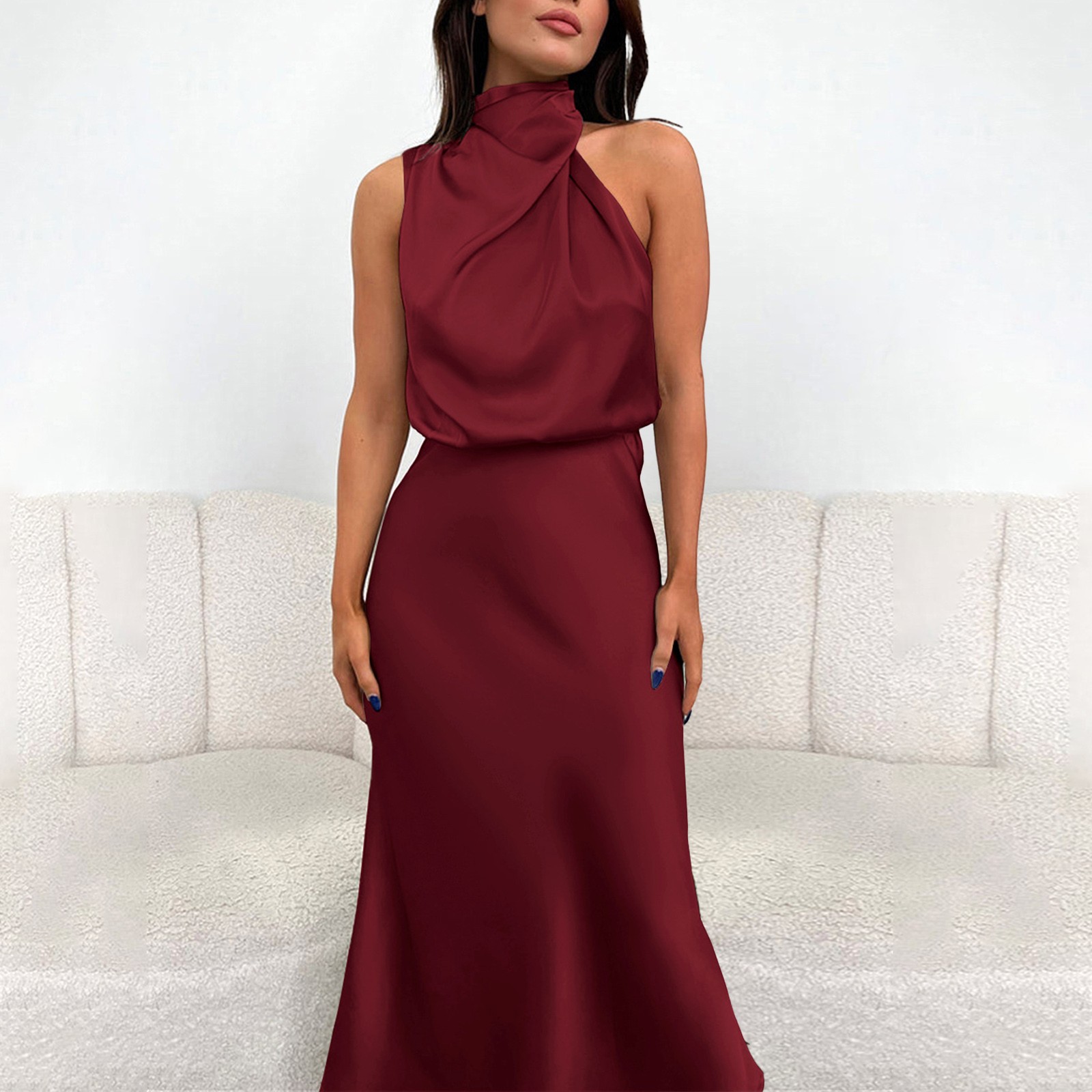Introduction to Silk Formal Dresses
Silk formal dress have long been synonymous with luxury and elegance. Their allure transcends generations, making them an enduring favorite for formal events. From weddings and galas to red carpet-events and high-end parties, silk dresses are a go-to choice for those looking to make a sophisticated statement.

The History and Charm of Silk
Silk is one of the oldest and most treasured fabrics in the world. Its origins date back thousands of years to ancient China. According to legend, the empress Leizu discovered silk around 2700 BC when a silkworm cocoon fell into her tea and unraveled. This serendipitous event led to the development of sericulture, the practice of cultivating silkworms for their silk.
The unique qualities of silk—its luster, smooth texture, and strength—made it a highly sought-after fabric. The Silk Road, a network of trade routes connecting the East and West, facilitated the exchange of silk, making it a symbol of wealth and status. The fabric’s luxurious reputation has endured, and today, wearing a silk formal dress signifies sophistication and timeless beauty.
Why Choose Silk?
Silk dresses offer a multitude of benefits. First and foremost, silk is incredibly comfortable to wear. It is soft against the skin and has a natural breathability that keeps you cool in warm weather and warm in cool weather. This adaptability makes silk suitable for various climates and seasons.
In addition to comfort, silk has an unmatched aesthetic appeal. The fabric drapes beautifully, creating a flattering silhouette that enhances the wearer’s figure. The natural sheen of silk catches the light in a way that no other fabric can, creating a radiant and elegant look. This makes silk dresses perfect for formal occasions where you want to stand out and make a lasting impression.
Silk is also a durable fabric. Despite its delicate appearance, silk fibers are strong and resilient. With proper care, a silk dress can last for many years, making it a worthwhile investment for your wardrobe. Moreover, silk is hypoallergenic, making it suitable for individuals with sensitive skin.

Types of Silk Used in Formal Dresses
Not all silk is created equal. There are several types of silk, each with its own unique characteristics. Understanding these differences can help you choose the perfect silk dress for your needs.
Charmeuse Silk
Charmeuse silk is one of the most popular types of silk used in formal dresses. It is known for its glossy front and matte back. The high sheen of charmeuse silk gives it a luxurious appearance, making it ideal for evening gowns and cocktail dresses. This type of silk drapes beautifully and clings to the body, creating a sleek and elegant silhouette.
Chiffon Silk
Chiffon silk is lightweight and sheer, giving it a delicate and ethereal quality. It is often used in flowing, layered dresses that create a sense of movement and grace. Chiffon silk is perfect for romantic and feminine designs, such as bridesmaid dresses and formal gowns. Its airy nature also makes it comfortable to wear, especially in warmer weather.
Dupioni Silk
Dupioni silk is characterized by its crisp texture and subtle sheen. It is woven from irregular silk threads, which give it a slightly rough texture and a distinctive, shimmery appearance. Dupioni silk holds its shape well, making it suitable for structured dresses and gowns. It is often used in wedding dresses and formal attire where a more tailored look is desired.
Organza Silk
Organza silk is another lightweight and sheer fabric, but it is stiffer than chiffon. This stiffness allows organza to hold its shape well, making it ideal for full skirts and dresses with voluminous silhouettes. Organza silk adds a touch of drama to any formal dress, making it a popular choice for evening wear and bridal gowns.
Taffeta Silk
Taffeta silk is known for its crisp texture and slight sheen. It is a medium-weight fabric that holds its shape well, making it suitable for structured and voluminous dresses. Taffeta silk creates a rustling sound when it moves, adding an extra element of elegance to your attire. It is often used in ball gowns and evening dresses where a dramatic effect is desired.

Designing the Perfect Silk Formal Dress
Designing a silk formal dress involves careful consideration of several factors. From the silhouette and neckline to the length and embellishments, every detail plays a crucial role in creating a stunning dress that suits the occasion and the wearer’s style.
Choosing the Silhouette
The silhouette of a dress refers to its overall shape and structure. When selecting a silhouette for a silk formal dress, consider your body type and the formality of the event. Here are some popular silhouettes:
- A-line: An A-line dress is fitted at the waist and gradually flares out towards the hem, creating a flattering and versatile shape. This silhouette suits most body types and is perfect for both formal and semi-formal events.
- Ball Gown: A ball gown features a fitted bodice and a full, voluminous skirt. This silhouette is ideal for grand occasions such as black-tie events and weddings. It creates a dramatic and regal look that is sure to turn heads.
- Sheath: A sheath dress is fitted through the entire length of the dress, hugging the body’s curves. This silhouette is sleek and sophisticated, making it suitable for more formal and elegant events.
- Mermaid: A mermaid dress is fitted through the bodice and hips, flaring out at the knees. This silhouette accentuates the curves and creates a glamorous and dramatic look, perfect for high-profile events and red-carpet appearances.
Selecting the Neckline
The neckline of a dress can significantly impact its overall look and feel. When choosing a neckline for a silk formal dress, consider your personal style and the level of coverage you desire. Some popular necklines include:
- Sweetheart: The sweetheart neckline is shaped like the top of a heart, creating a romantic and feminine look. It is flattering for most body types and adds a touch of elegance to any dress.
- V-neck: A V-neckline creates a plunging effect that elongates the neck and draws attention to the décolletage. It is a versatile neckline that suits both casual and formal dresses.
- Halter: A halter neckline features straps that wrap around the neck, leaving the shoulders and back exposed. This neckline is perfect for showcasing toned arms and shoulders and adds a modern and chic touch to the dress.
- Off-the-shoulder: An off-the-shoulder neckline sits below the shoulders, highlighting the collarbones and shoulders. This neckline is both elegant and trendy, making it suitable for formal and semi-formal occasions.

Considering the Length
The length of a silk formal dress can vary depending on the formality of the event and personal preference. Here are some common lengths for formal dresses:
- Floor-Length: A floor-length dress extends to the ground, creating a dramatic and elegant look. This length is ideal for black-tie events, galas, and formal weddings.
- Tea-Length: A tea-length dress falls between the knee and the ankle. It is a versatile length that is suitable for both formal and semi-formal occasions. Tea-length dresses are often seen at garden parties, daytime weddings, and cocktail events.
- Knee-Length: A knee-length dress falls just above or below the knee. This length is more casual compared to floor-length dresses but still maintains a sense of elegance. Knee-length dresses are suitable for semi-formal events and cocktail parties.
Adding Embellishments
Embellishments can elevate the look of a silk formal dress, adding a touch of glamour and sophistication. Some popular embellishments include:
- Beading: Intricate beadwork can add sparkle and texture to a dress. Beads can be used to create patterns, add accents, or completely cover certain areas for a dazzling effect.
- Lace: Lace overlays or appliqués add a romantic and vintage-inspired touch to a silk dress. Lace can be used to highlight certain areas, such as the neckline or sleeves, or create an entire lace overlay for a delicate and refined look.
- Sequins: Sequins can add a bold and eye-catching element to a dress. They reflect light and create a shimmering effect, making them perfect for evening wear and special occasions.
- Embroidery: Embroidered details can add an artistic and personalized touch to a dress. Embroidery can be used to create intricate designs, monograms, or motifs that enhance the overall look of the dress.
Caring for Your Silk Formal Dress
Silk is a delicate fabric that requires special care to maintain its beauty and longevity. Proper care ensures that your silk formal dress remains in pristine condition for years to come.
Cleaning and Storing
When it comes to cleaning a silk dress, always check the care label for specific instructions. In general, dry cleaning is the safest option for silk garments. If you choose to hand wash your dress, use a gentle detergent and cool water. Avoid wringing or twisting the fabric, as this can cause damage. Instead, gently press out excess water and lay the dress flat to dry.
Storing a silk dress properly is essential to prevent wrinkles and damage. Store the dress in a cool, dry place away from direct sunlight. Use a padded hanger to maintain the shape of the dress, and cover it with a breathable garment bag to protect it from dust and insects.
Handling Stains
If your silk dress gets stained, it’s important to act quickly. Blot the stain gently with a clean cloth to remove excess liquid. Avoid rubbing the stain, as this can cause it to spread. For stubborn stains, take the dress to a professional cleaner with experience in handling silk garments.
Avoiding Damage
Silk is vulnerable to damage from chemicals, heat, and friction. To avoid damage, handle your silk dress with care. Keep it away from perfumes, deodorants, and hairsprays, as these substances can cause discoloration. Avoid exposing the dress to direct sunlight for extended periods, as UV rays can weaken the fibers and cause fading.
Ironing silk requires caution. Use the lowest heat setting on your iron and place a pressing cloth between the iron and the fabric to prevent scorching. Alternatively, use a steamer to gently remove wrinkles without applying direct heat.

Conclusion: The Enduring Appeal of Silk Formal Dresses
Silk formal dress continue to captivate with their timeless elegance and luxurious feel. From their historical significance to their modern-day versatility, silk dresses remain a beloved choice for formal occasions. Whether you’re attending a wedding, a gala, a cocktail party, or a corporate event, a silk formal dress ensures that you’ll look and feel your best.
Choosing the right type of silk, silhouette, neckline, length, and embellishments allows you to create a dress that perfectly suits your style and the occasion. Proper care and handling will ensure that your silk dress remains a cherished part of your wardrobe for years to come.


